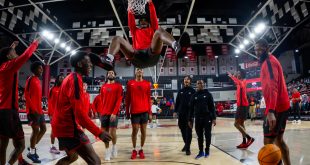The season is far from over and the rankings are subject to change, but undeniable evidence suggests this: The current Division II Golf postseason format is rigged against southern teams and does more harm than good.
The issue above all is the NCAA’s concept of “regionalization.” It’s the idea that all regions in the country should have equal representation in the postseason. One could argue that this could be a potential problem in all Division II sports, but considering the following, it would appear that this issue affects the sport of golf more than any other:
- The Division II national champion is determined in the end with an eight-team match play tournament. In the current GCAA Coaches Poll, seven of the top eight teams hail from the South Region (Barry, Florida Southern, Lynn, Saint Leo, Nova Southeastern, Florida Tech and West Florida). 8 Carson-Newman and No. 9 USC Aiken are in the Southeast Region (more on that later). This isn’t an anomaly or shocking occurrence by any means.
- Ten teams represent each region in the postseason. Currently, there are eight teams from the South Region found in the Coaches Poll. Factor in the teams that aren’t necessarily the best in the region but get in via automatic bids, and you realize that one very good team at the minimum will have to stay at home. Last season, Albany State got in because of their SIAC title, and because of this, only one spot remained. Both Lee and VSU, who were far better teams, missed out on the postseason. Don’t believe me? I think the fact that Albany State shot +106 and was 76 shots behind 19th place Newberry College in the super regional tournament says enough (In case you’re wondering, there are 20 teams who play in each super regional tournament.).
- Sixteen of the current top 25 teams in the Coaches Poll come from either the South or Southeast Region. In last season’s South/Southeast Super Regional tournament, the lowest ranked team of the 19 other than Albany State was Georgia Southwestern at No. 42 in the GolfStat Rankings All of the top 11 teams in this ranking were present at this tournament as were 15 of the top 20. To start the postseason, the 20 teams from each of these 10 team regions play in the Super Regional tournament. That means that many of the nation’s best will be eliminated long before a national champion is decided.
- There are six other regions, and the last seven national champions have either come from the South or the Southeast Regions. In the last 20 years, 18 of them have been South/Southeast region teams, with the two exceptions being Sonoma State in 2009 and Cal State Monterey Bay in 2011. Prior to 2009, the last non-South/Southeastern national champion was Abilene Christian in 1993. Going back further, the last non-South/Southeast champion was Southwest Texas State in 1983. You get the point; a non-southern champion is an awfully rare occurrence.
Under the current system, the teams’ fate in the postseason is determined by their geographic location, and with talent of these teams obviously not distributed evenly or even close to being so, this significant problem that has persisted must be solved.
The obvious and simple solution would be to adopt the current Division I model, a system similar to college basketball’s March Madness, where a selection committee seeds teams and then places them into regions. With this format, we could have the closest thing to the 80 best teams playing each other in a way that the best teams aren’t eliminated early on or are excluded from the postseason entirely for the matter.
It would make the postseason much more dramatic and far more interesting, considering, under the current model, the best postseason test for these teams occurs in the Super Regional and not in the National Championship.
Let’s make it an initiative to prevent a team like last year’s Blazers from getting excluded from the 80-team field. The No. 32-ranked team finished third in one of the nation’s best conference’s conference tournament and had two All-Gulf South performers in Matt Anderson and Davis Roche, ranked the 44th and 61st overall individual players in the nation by GolfStat respectively.
The objection is this: It’s how we’ve always done it, and that’s how we do it for every sport, so why change it?
The first answer, already articulated, is the fact that there is and has been an uneven distribution of talent when comparing the regions with the South and Southeast clearly having the upper-hand.
The South/Southeast Super Regional, the Southeastern Collegiate hosted by VSU at Kinderlou Forest, and other notable conference championships and events have stronger fields than the Division II National Championship.
At this point your question is probably this: Why golf?
An expert could probably come up with several reasons, but the primary reason for it being more of an issue in the sport than others mainly involves the weather.
With golf being an exclusively outdoor sport, players who live in the north naturally are at a disadvantage because the courses have to be closed due to snow. In general, the cold weather just isn’t favorable for play, particularly during the winter months and early spring.
With indoor sports like basketball or volleyball, players can still train without the weather holding them back. When it comes to football, players can work out in weight rooms or practice drills at indoor field facilities.
While indoor driving ranges and putting greens exist, the drawback of not being able to play on the course is still devastating for northern players. Those living in the south can play rounds almost on a 12-month basis.
This gives college coaches from the south an advantage in recruiting, given that prep players are more likely to go to colleges nearby already, and a top player in the south would have no incentive to attend a northern school if he knows the closer options field better teams. Northern schools, while they can hypothetically recruit players who are far away, also have to deal with the disadvantage of not having the resources to develop athletes as effectively.
For international players, southern schools are much more attractive.
Having a situation that persists to exist and has no indication of change, I believe that the NCAA, even if it wishes to live by its “regionalization” principle, should make an exception for golf where a change is desperately needed.
While VSU may not be a victim of the flawed format this time around, it will be somebody. Either way, a change is long overdue.
Written by Bryant Roche, Staff Writer. Photo by Bethany Davis.
For more sports click here.
 The Spectator The independent student newspaper of Valdosta State University
The Spectator The independent student newspaper of Valdosta State University





